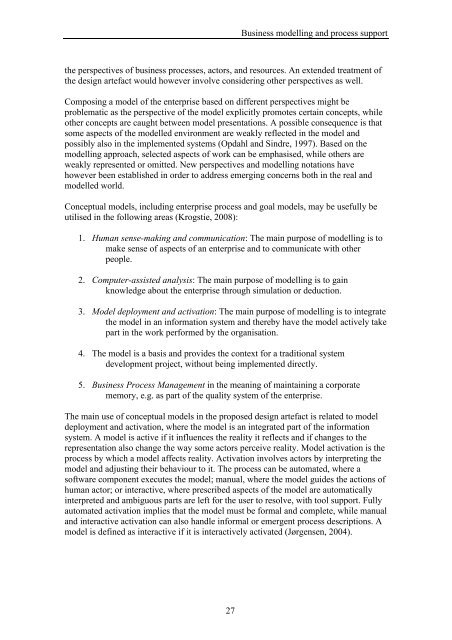Multi-channel provisioning of public services - Department of ...
Multi-channel provisioning of public services - Department of ...
Multi-channel provisioning of public services - Department of ...
You also want an ePaper? Increase the reach of your titles
YUMPU automatically turns print PDFs into web optimized ePapers that Google loves.
Business modelling and process support<br />
the perspectives <strong>of</strong> business processes, actors, and resources. An extended treatment <strong>of</strong><br />
the design artefact would however involve considering other perspectives as well.<br />
Composing a model <strong>of</strong> the enterprise based on different perspectives might be<br />
problematic as the perspective <strong>of</strong> the model explicitly promotes certain concepts, while<br />
other concepts are caught between model presentations. A possible consequence is that<br />
some aspects <strong>of</strong> the modelled environment are weakly reflected in the model and<br />
possibly also in the implemented systems (Opdahl and Sindre, 1997). Based on the<br />
modelling approach, selected aspects <strong>of</strong> work can be emphasised, while others are<br />
weakly represented or omitted. New perspectives and modelling notations have<br />
however been established in order to address emerging concerns both in the real and<br />
modelled world.<br />
Conceptual models, including enterprise process and goal models, may be usefully be<br />
utilised in the following areas (Krogstie, 2008):<br />
1. Human sense-making and communication: The main purpose <strong>of</strong> modelling is to<br />
make sense <strong>of</strong> aspects <strong>of</strong> an enterprise and to communicate with other<br />
people.<br />
2. Computer-assisted analysis: The main purpose <strong>of</strong> modelling is to gain<br />
knowledge about the enterprise through simulation or deduction.<br />
3. Model deployment and activation: The main purpose <strong>of</strong> modelling is to integrate<br />
the model in an information system and thereby have the model actively take<br />
part in the work performed by the organisation.<br />
4. The model is a basis and provides the context for a traditional system<br />
development project, without being implemented directly.<br />
5. Business Process Management in the meaning <strong>of</strong> maintaining a corporate<br />
memory, e.g. as part <strong>of</strong> the quality system <strong>of</strong> the enterprise.<br />
The main use <strong>of</strong> conceptual models in the proposed design artefact is related to model<br />
deployment and activation, where the model is an integrated part <strong>of</strong> the information<br />
system. A model is active if it influences the reality it reflects and if changes to the<br />
representation also change the way some actors perceive reality. Model activation is the<br />
process by which a model affects reality. Activation involves actors by interpreting the<br />
model and adjusting their behaviour to it. The process can be automated, where a<br />
s<strong>of</strong>tware component executes the model; manual, where the model guides the actions <strong>of</strong><br />
human actor; or interactive, where prescribed aspects <strong>of</strong> the model are automatically<br />
interpreted and ambiguous parts are left for the user to resolve, with tool support. Fully<br />
automated activation implies that the model must be formal and complete, while manual<br />
and interactive activation can also handle informal or emergent process descriptions. A<br />
model is defined as interactive if it is interactively activated (Jørgensen, 2004).<br />
27
















